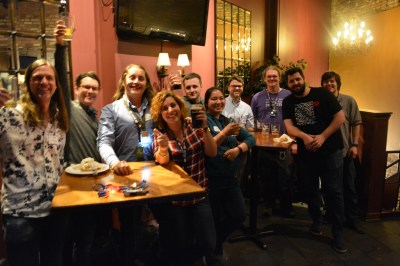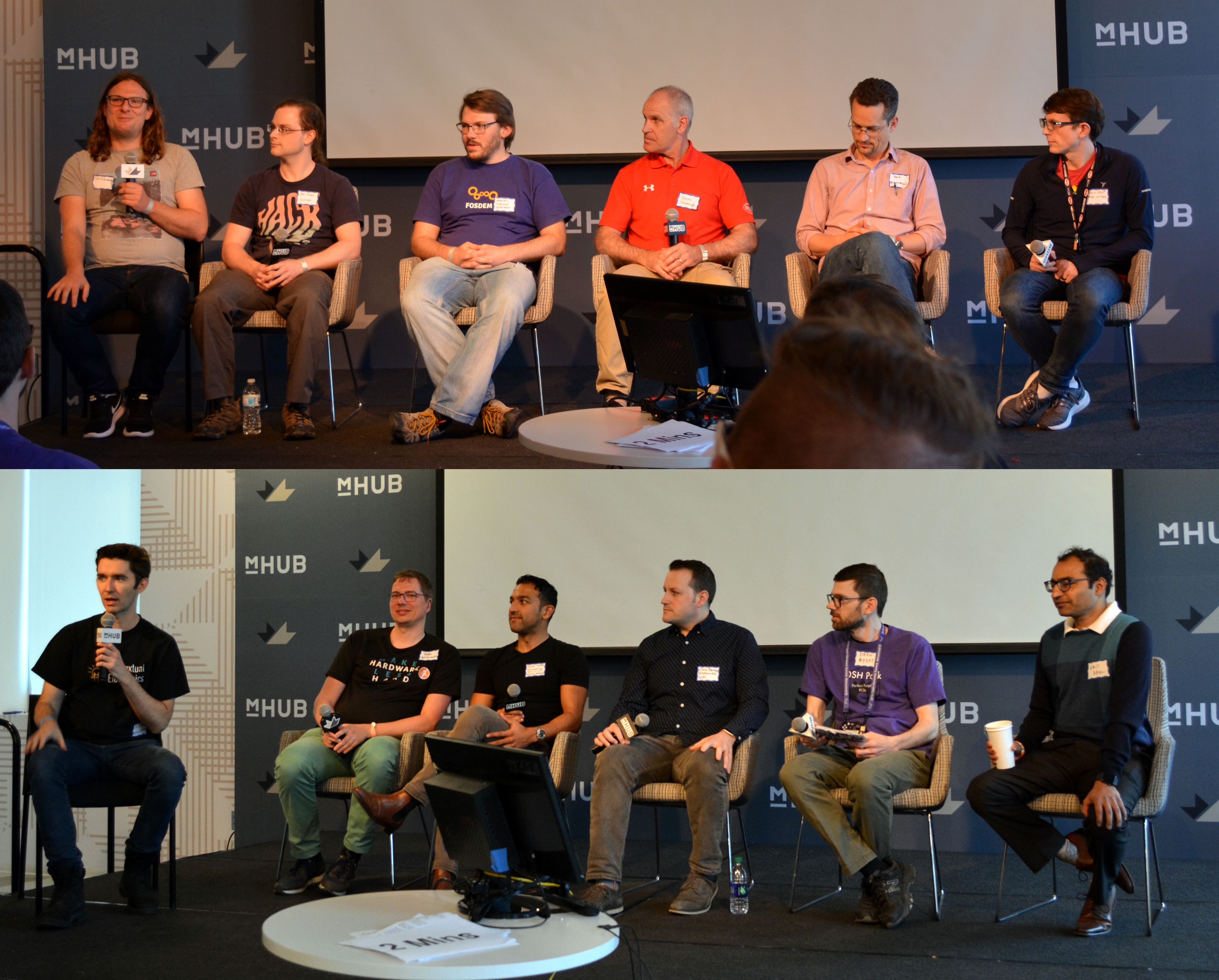Last weekend was KiCon, a gathering of hardware developers from all over the world who use KiCad open source EDA software. This included many of the software engineers who drive development, people who use KiCad in their business, and those who simply love it for being a professional quality tool available for anyone to use.
From hardware show-and-tell, to the lineup of talks, and the social events each evening, there was so much packed into two (plus) days. Join me after the break for a whirlwind tour of the people and the hardware found at 2019 KiCon.
The Community

Top of Article: Main room at Hackaday afterparty
Chris Gammell organized this conference and he did a fantastic job. The event transcended the walls of mHub — the manufacturing-oriented co-working space where KiCon was held — and included social events for three nights during the event.
Everyone who arrived in town on Thursday night came out to Hardware Happy Hour Chicago for a long evening including many hardware demos. As the talks wrapped up on Friday night we hopped on the train and partied at Pumping Station: One, a huge hackerspace on the north side of the city. And the fun continued past the official end of KiCon as Hackaday helped host an afterparty. All three of these nights were packed and delivered a much needed dose of unscheduled time to meet everyone and catch up with what has been going on in their parts of the hardware universe.
The Badge
To my delight there was a hardware badge for KiCon designed by Maciej Sumiński. The simple board packs a lot of punch, with functionality as an 8-channel logic analyzer, a simple oscilloscope, USB-to-UART, and the ability to control GPIO via USB. The hardware design is based on the LQFP-64 Atmel/Microchip ATSAM4SD16BA, which includes a whopping 1 MB 160 kB of RAM and runs at 120 MHz. The user interface is an OLED display with four user buttons.
[tweet https://twitter.com/szczys/status/1122268646108225536 width=’400′ align=’right’]
A small portable battery was the power source. The badge was too low-power to keep that battery awake but that could be fixed by soldering some resistors onto a decoupling cap, allowing me to display my own animations as my name badge during the con.
The Talks
How much can you say about EDA software? Like any good tool, the uses are endless and I enjoyed hearing as much about unique use cases as I did about how they were overcome. The talks were recorded and I will be watching for those to be made available because the two talk venues made it impossible to see everything. (Update: they will be published on the Contextual Electronics channel)
One talk I certainly didn’t miss was Wayne Stambaugh’s keynote as the KiCad project leader. This has been, and remains a labor of love for all involved. But the big news is that Wayne has been hired full-time to work on the KiCad project, an incredible contribution to the Open Source community by the company Wit. This news came at the end of the talk after discussing plans for version 6; new schematic and symbol library file formats, Python scripting for schematics, drag and drop from symbol library to schematic editor, hatch zone filling, SVG import to boards, ratsnest curving, coloring, and visibility support were among the mentioned efforts.

Bottom: Manufacturers Panel
The panels were what I enjoyed the most from the talks. These are sessions with multiple people on stage where the conversation is led by a moderator and the audience is free to ask questions. Coming from a very interested crowd, questions were thoughtful and considerate, and those questions guided incredible discussions during both the KiCad developers panel and the manufacturers panel.
The Hacks
KiCon turned out a lot of hardware designers and they didn’t leave their pet projects at home.
This ski goggle LED board is fascinating in itself, but the design process was also the topic of Uriel Guy’s talk at the con. He wrote a C# wrapper for KiCad which will do the repetitive work of placing the LEDs and the board cutouts that let you see through the matrix. But the real gobsmacker is the jig for the curved control board — that jig was auto generated and pretty much everyone who’s ever manufactured anything will be interested in that feature.
Morgan showed up at Thursday night’s meetup wearing a badge he made that is simply perfection. The top lid is a bezel of PCB with pink LEDs on the underside to illuminate the electronics and battery inside. The sides and back of the case are also PCB, notched together, with control buttons on the side. There’s a PCB lanyard eyelet on the top, and a USB charging port on the bottom.
I ran into the engineers behind Wayne and Layne who were both wearing their I can solder SMT boards. I enjoy these because they are programmed optically using the phototransistors along the top edge.
You’ve likely seen the incredible circuit sculptures Mohit Bhoite has been building. He brought along a gorgeous game of snake with a wooden handle, thumbstick, and air-wired LED matrix. He tells me he transports it in a Pelican case to keep it safe.
The wristwatch above is a fitness tracker design that Joel Murphy is working on. It has a step tracker (the silicon actually does the processing to detect steps) and a heart rate monitor. Joel’s technique for attaching the watch band is interesting, the lug hole is a castellation with a surface mount resistor on top and bottom to keep the lug in place.
Eric Carr showed up to the Hackaday meetup with a case of (protoype?) Pinebook laptops. Of course people started breaking out tools and doing a teardown! I also enjoyed seeing the Eurorack face plate shown here which is a PCB manufactured with aluminum substrate. Apparently this is a common option for PCB designs that use high-powered LEDs.
This conference brought together amazing people to celebrate hardware design using Open Source tools beyond just KiCad. I learned about 3D modelling, I heard some insight on what manufacturers go though to build the designs we send them, and I heard directly from the software engineers that drive KiCad. There was simply way too much to fit in two days of this conference — although we still all tried to do everything. I think I speak for all involved in saying this went off without a hitch and I can’t wait for the next KiCon!















Correction: The MCU has 1MB of *flash*, not RAM. It has 160kB of embedded SRAM, which is still quite good but nowhere near 1MB.
Thanks, fixed!
Where does the curved circuit board sit in relation to the goggle matrix?
Im going to take a wild guess and say that it sits on top in the area between the front bezel that holds the lens and the foam backing that touches the face. It looks about the right size and is better than the option of having the electronics clipped to the head band.
You’re correct. the curved board goes on the right side of the goggles. The photo actually shows the bottom of the board, the top has an encoder and some buttons for control.
nice! whats the model of goggles that you use? do you have any plans to offer something like this as a product?
I do, although right now I’m having too much fun at work so my side projects are kind of on the side burner.
it’s a CRG Motocross goggles. can’t remember the exact model.
if this is just a side project then i would suggest going the route of a universal kit kind of idea. Maybe a few different profiles that would fit inside different goggle types? I wouldn’t buy a new set of goggles but i would buy a kit that i could fit into my existing snowboard goggles.
And here is a place to use the goggles!
https://rootsrated.com/stories/steamboat-illuminated-lighted-man-steamboat-winter-carnival
I was planning more on Burning Man, but this looks awesome!
Or this https://youtu.be/EHV1bonXsk8?t=15 or this https://youtu.be/GBpxSNMWtto?t=59
Oh man, I love the badge. It has one more feature you didn’t notice. If you plug it in it acts as a read only USB storage device. It’s awesome, it contains the Eagle files so you can make your own badge!
The WHAT?!
Tee-hee!
The correct link for mHub is https://mhubchicago.com/
Oof, got it. Thanks!
Session videos to be posted soon? (other than the manufacturing vid)
The LEDs in The Cacoffiny are APA102-2020 not plain pink.
KiCad is still freaking awful without a real auto-router, unless your into that kind of sadomasochistic kink. But i guess free for hobby level stuff or ubernerd street-cred for that full blown x64 motherboard done entirely by trace-dragging its ok…
Would you like to write an autorouter for KiCad? :D
you can autoroute KiCAD stuff.
Routing BGA chips by hand is honestly rather fun, once you get the hang of it.
The stuff I do – I like laying it out by hand. But I have maybe 100 nets .. sdeveral thousand would be “a bit much”.